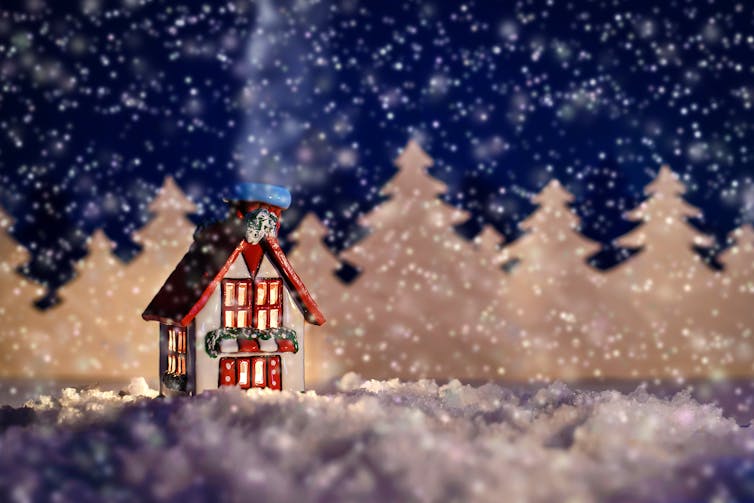What psychiatrists have to say about holiday blue
Linda Saab, Wayne State University and Arash Javanbakht, Wayne State University
This time of the year brings a lot of changes to the usual day-to-day life of hundreds of millions of people: The weather is colder, trees are naked, snowy days become plentiful and friendly critters are less visible around the neighborhood. Especially in the Western Hemisphere, this time of the year is also linked to a lot of joyous celebrations and traditions. Most children and many adults have been excited for this time of the year to come for months, and they love the aura of celebrations, with their gatherings, gifts, cookies, emails and cards.
Alas, there are also millions who have to deal with darker emotions as the world literally darkens around them.
The holiday blues – that feeling of being in a lower or more anxious mood amid the significant change in our environment and the multitude of stressors that the holidays can bring – is a phenomenon that is yet to be researched thoroughly. However, as academic psychiatrists and neuroscience researchers, we have seen how several factors contribute to this experience.
Why feel blue in the red and green season?
There are many reasons to feel stressed or even downright overwhelmed during this time of year, in addition to the expectations set around us.
Memories of holidays past, either fond or sad, can create a sense of loss this time of year. We may find ourselves missing people who are no longer with us, and carrying on the same traditions without them can be a strong reminder of their absence.
The sense of burden or obligation, both socially or financially, can be significant. We can get caught up in the commercial aspects of gift giving, wanting to find that perfect item for family and friends. Many set their sights on special gifts, and we often can feel stretched thin trying to find a balance between making our loved ones happy and keeping our bank accounts from being in the black.

Holiday parties, fun though they may be, can also bring conflict. My Agency/Shutterstock.com
It’s also a time for gathering with those close to us, which can stir up many emotions, both good and bad. Some may find themselves away from or without close connections and end up isolated and withdrawn, further disconnected from others. On the other hand, many people find themselves feeling overwhelmed by the combination of potlucks and Secret Santas stacking up through multiple invitations, be it at school, work, or from friends and family – leaving us with the difficult position of not wanting to disappoint others, while not getting totally depleted by all the constant socializing.
Great expectations
People often feel disappointed when reality does not meet expectations. The larger the mismatch, the worse the negative feelings. One of us (Arash) often finds himself telling his patients: Childhood fairy tales can set an unrealistic bar in our minds about life. I wish we were told more real stories, taking the bad with the good, as we would get hurt less when faced with difficult realities of life, and learn how to especially appreciate our good fortunes.

Fairy tales rarely come true, but people seem to hold out hope that they do. Shamilini/www.shutterstock.com
These days viewers are showered with Christmas and New Year’s Eve movies, almost all of which sound and feel like fairy tales. People get married, get rich, fall in love or reconnect with their loved ones. Even unhappy events within “A Christmas Carol” conclude with a happy ending. These all, besides exposure to only happy moments and beautiful gifts (courtesy of Santa), dazzling Christmas decorations, and picturesque family scenes on social media, often set an unrealistic expectation for how this time of the year “should” feel.
Reality is different, though, and at its best is not always as colorful. There may be disagreements about hows, wheres, whats and whos of the celebration, and not all family members, friends and relatives get along well at parties. And as we feel lonelier, we may find ourselves spending more time immersed in TV and social media, leading to more exposure to unrealistic views of the holidays and feeling all the worse about our situation.
When is blue a red flag?
While many experience the more transient “holiday blues” this time of year, it is important not to miss more serious conditions like seasonal mood changes, which in its most severe case leads to clinical depression, including Seasonal Affective Disorder. SAD consists of episodes of depression or a worsening of existing depression during the late fall and early winter. The person may feel depressed and hopeless, or they may find it difficult to focus, sleep, or be motivated – they can even feel suicidal. As our emotions can color our thoughts and memories, a depressed person may remember more negative memories, have a more negative perception and interpretation of the events, and feel upset about the holidays.
In such cases, the sadness is “coincident” with the holidays and not caused solely by its circumstances. It is important to seek professional help with SAD, as we have effective treatments available, such as medications and light therapy.
What to do to minimize the blues?
Set realistic expectations: One readily available strategy is simply reframing the beliefs we have about what the holidays “should” be like. Not all parties will go perfectly. Some decorations may break, or kids may wake up grumpy or not be exhilarated by their gifts – but it doesn’t have to stop us from enjoying all the good moments.
Set firm boundaries: Too many invitations to social events? Too many financial demands? Set clear limits about what you are able and willing to do, whether that means declining some social events and setting your own limit on spending this year, focusing more on meaningful experiences over expense. This can be spending time with loved ones or getting creative with homemade gifts.
Feeling alone? There are many ways to steer clear of isolating this time of year. Reaching out to friends, volunteering at animal shelters, local charities or attending community meetups or religious events can be a great way to stay connected while also bringing happiness to ourselves and others.
Making new memories: Starting a new tradition, either solo or with loved ones, can help create fond new memories of the holidays, no longer overshadowed by the past.
Take care of yourself: It’s important to remember the value of self-care, including eating and drinking in moderation (as alcohol can worsen a depressed mood), exercising (even a short walk), and treating yourself this holiday season by doing something you enjoy.
![]() While the holiday blues are most often temporary, it’s important to identify when things have crossed over into clinical depression, which is more severe and longer lasting. It also impairs daily functioning. For these symptoms it is often helpful and necessary to seek professional help. This can consist of counseling or use of medications, or both, to help treat symptoms.
While the holiday blues are most often temporary, it’s important to identify when things have crossed over into clinical depression, which is more severe and longer lasting. It also impairs daily functioning. For these symptoms it is often helpful and necessary to seek professional help. This can consist of counseling or use of medications, or both, to help treat symptoms.
Linda Saab, Assistant Professor of Psychiatry, Wayne State University and Arash Javanbakht, Assistant Professor of Psychiatry, Wayne State University
This article was originally published on The Conversation. Read the original article.
